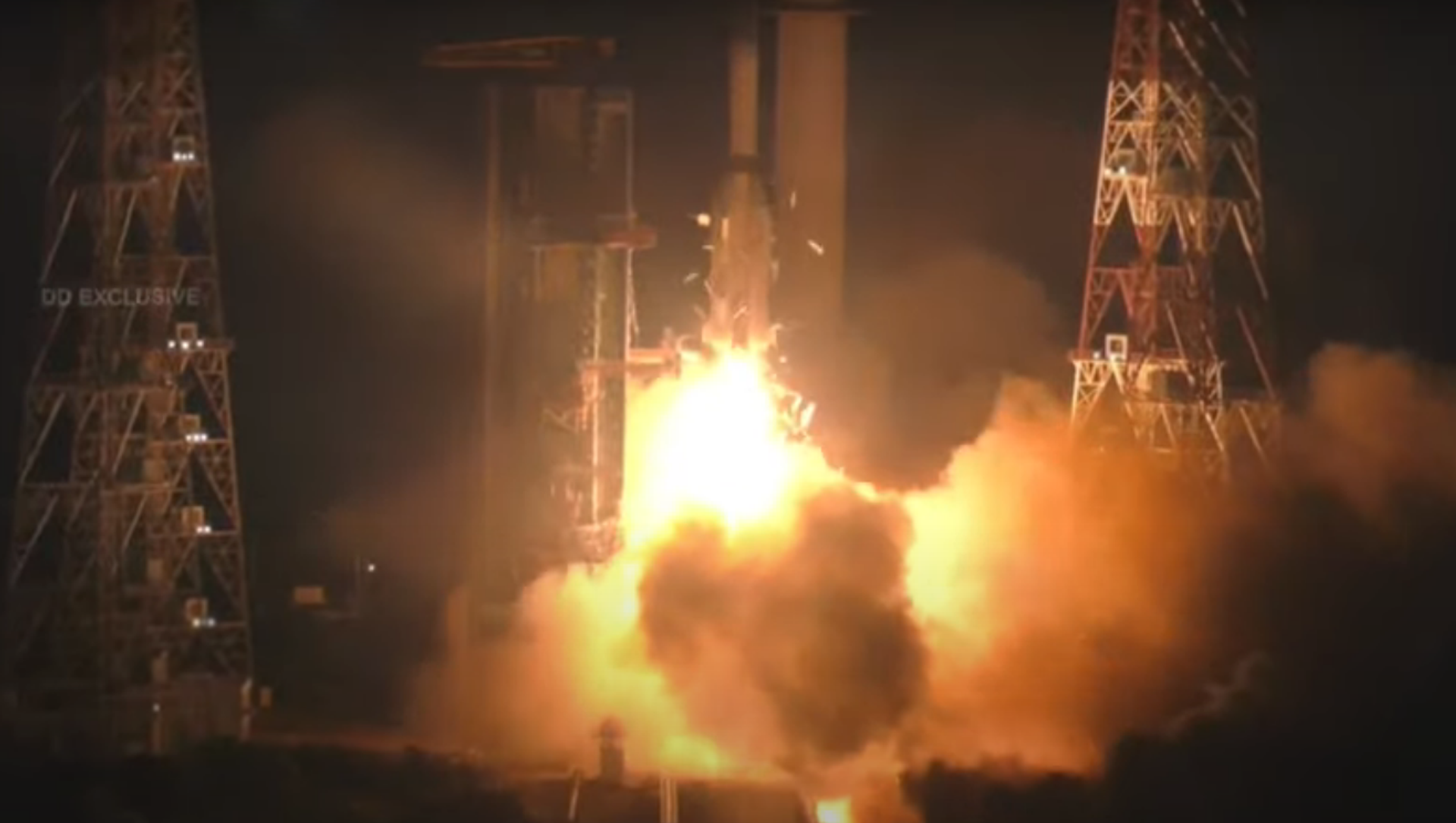https://sputnikglobe.com/20210812/indians-space-agency-isro-launches-countrys-first-state-of-art-earth-observation-satellite-1083584811.html
Indian Space Agency ISRO Launches Country's First State-of-Art Earth Observation Satellite
Indian Space Agency ISRO Launches Country's First State-of-Art Earth Observation Satellite
Sputnik International
Earlier this year, India's Space Agency ISRO successfully launched Brazil's earth observation satellite Amazonia-1 and 18 co-passenger satellites. The mission... 12.08.2021, Sputnik International
2021-08-12T00:20+0000
2021-08-12T00:20+0000
2022-07-19T10:38+0000
newsfeed
world
indian space research organization (isro)
satellite
satellite imaging
https://cdn1.img.sputnikglobe.com/img/07e5/08/0c/1083585012_81:0:1397:744_1920x0_80_0_0_d173df8060ff85df69c7af41a79afa15.png
The Indian Space Research Organisation (ISRO) on Thursday launched Earth observation satellite EOS-03 on the GSLV launcher from the Satish Dhawan Space Centre (SDSC) SHAR, Sriharikota. The EOS-03 launch was scheduled at 5:43 am (IST) and it will be placed in a Geosynchronous Transfer Orbit by the GSLV-F10. Later, the satellite will reach its final geostationary orbit using an onboard propulsion system. On Wednesday at 03:43 am IST, ISRO commenced the countdown for the launch of the GSLV-F10/EOS-03 mission.In a first, a 4-metre diameter Ogive-shaped payload fairing is being flown in the GSLV mission. According to the ISRO, EOS-03 will provide real-time pictures of large area regions of interest more frequently and provide crucial insight into agriculture, forestry, disaster warning, cyclone monitoring and other sectors.The much-awaited mission was originally scheduled to launch in March 2020 and later in April and in May this year but was postponed due to the second wave of the COVID-19 pandemic. At 3:36 am (IST) on Thursday the space agency tweeted that the filling of liquid oxygen for the cryogenic stage (GS3) had begun.Just 19 minutes after liftoff, the separation of the satellite from the launch vehicle is expected to take place. The country currently has two Earth observation satellites in geostationary orbit — the INSAT-3D, which was launched in 2013, and the INSAT-3DR, launched in 2016, both for weather monitoring.According to the Indian space agency, the EOS-03 will travel at the rate of the rotation of the planet and serve the purpose of "India's eye in the sky". Moreover, unlike low-Earth-orbit satellites, a geostationary satellite does not require constant readjustments to its position.The launch will mark the second flight for the Geosynchronous Satellite Launch Vehicle (GSLV) Mk III, which had earlier blasted off with the ambitious Chandrayaan-2 spacecraft to the Moon. ISRO is planning to conduct four similar launches in the next five months and, by the end of this year, the space agency is planning to launch its Small Satellite Launch Vehicle (SSLV).Due to the ongoing coronavirus pandemic, several crucial ISRO missions have been delayed. In November 2020, ISRO had launched EOS-01, the first in the series of new earth observation satellites.
https://sputnikglobe.com/20210715/indias-isro-successfully-tests-high-powered-rocket-engine-for-countrys-first-manned-mission-1083388440.html
Sputnik International
feedback@sputniknews.com
+74956456601
MIA „Rossiya Segodnya“
2021
Sushmita Panda
https://cdn1.img.sputnikglobe.com/img/07e5/05/12/1082926186_0:0:2048:2048_100x100_80_0_0_4474d0d7e27a36878eb8727832be74b4.jpg
Sushmita Panda
https://cdn1.img.sputnikglobe.com/img/07e5/05/12/1082926186_0:0:2048:2048_100x100_80_0_0_4474d0d7e27a36878eb8727832be74b4.jpg
News
en_EN
Sputnik International
feedback@sputniknews.com
+74956456601
MIA „Rossiya Segodnya“
Sputnik International
feedback@sputniknews.com
+74956456601
MIA „Rossiya Segodnya“
Sushmita Panda
https://cdn1.img.sputnikglobe.com/img/07e5/05/12/1082926186_0:0:2048:2048_100x100_80_0_0_4474d0d7e27a36878eb8727832be74b4.jpg
newsfeed, indian space research organization (isro), satellite, satellite imaging
newsfeed, indian space research organization (isro), satellite, satellite imaging
Indian Space Agency ISRO Launches Country's First State-of-Art Earth Observation Satellite
00:20 GMT 12.08.2021 (Updated: 10:38 GMT 19.07.2022) Earlier this year, India's Space Agency ISRO successfully launched Brazil's earth observation satellite Amazonia-1 and 18 co-passenger satellites. The mission, which was termed a "game-changer", was launched days before the country's 75th Independence Day.
The Indian Space Research Organisation (ISRO) on Thursday launched Earth observation satellite EOS-03 on the GSLV launcher from the Satish Dhawan Space Centre (SDSC) SHAR, Sriharikota. The EOS-03 launch was scheduled at 5:43 am (IST) and it will be placed in a Geosynchronous Transfer Orbit by the GSLV-F10. Later, the
satellite will reach its final geostationary orbit using an onboard propulsion system. On Wednesday at 03:43 am IST, ISRO commenced the countdown for the launch of the GSLV-F10/EOS-03 mission.
In a first, a 4-metre diameter Ogive-shaped payload fairing is being flown in the GSLV mission. According to the ISRO, EOS-03 will provide real-time pictures of large area regions of interest more frequently and provide crucial insight into agriculture, forestry, disaster warning, cyclone monitoring and other sectors.
The much-awaited mission was originally scheduled to launch in March 2020 and later in April and in May this year but was postponed due to the second wave of the COVID-19 pandemic. At 3:36 am (IST) on Thursday the space agency tweeted that the filling of liquid oxygen for the cryogenic stage (GS3) had begun.
Just 19 minutes after liftoff, the separation of the satellite from the launch vehicle is expected to take place. The country currently has two Earth observation satellites in geostationary orbit — the INSAT-3D, which was launched in 2013, and the INSAT-3DR, launched in 2016, both for weather monitoring.
According to the Indian space agency, the EOS-03 will travel at the rate of the rotation of the planet and serve the purpose of "India's eye in the sky". Moreover, unlike low-Earth-orbit satellites, a
geostationary satellite does not require constant readjustments to its position.
The launch will mark the second flight for the Geosynchronous Satellite Launch Vehicle (GSLV) Mk III, which had earlier blasted off with the ambitious Chandrayaan-2 spacecraft to the Moon. ISRO is planning to conduct four similar launches in the next five months and, by the end of this year, the space agency is planning to launch its Small Satellite Launch Vehicle (SSLV).
Due to the ongoing coronavirus pandemic, several crucial ISRO missions have been delayed. In November 2020, ISRO had launched EOS-01, the first in the series of new earth observation satellites.




